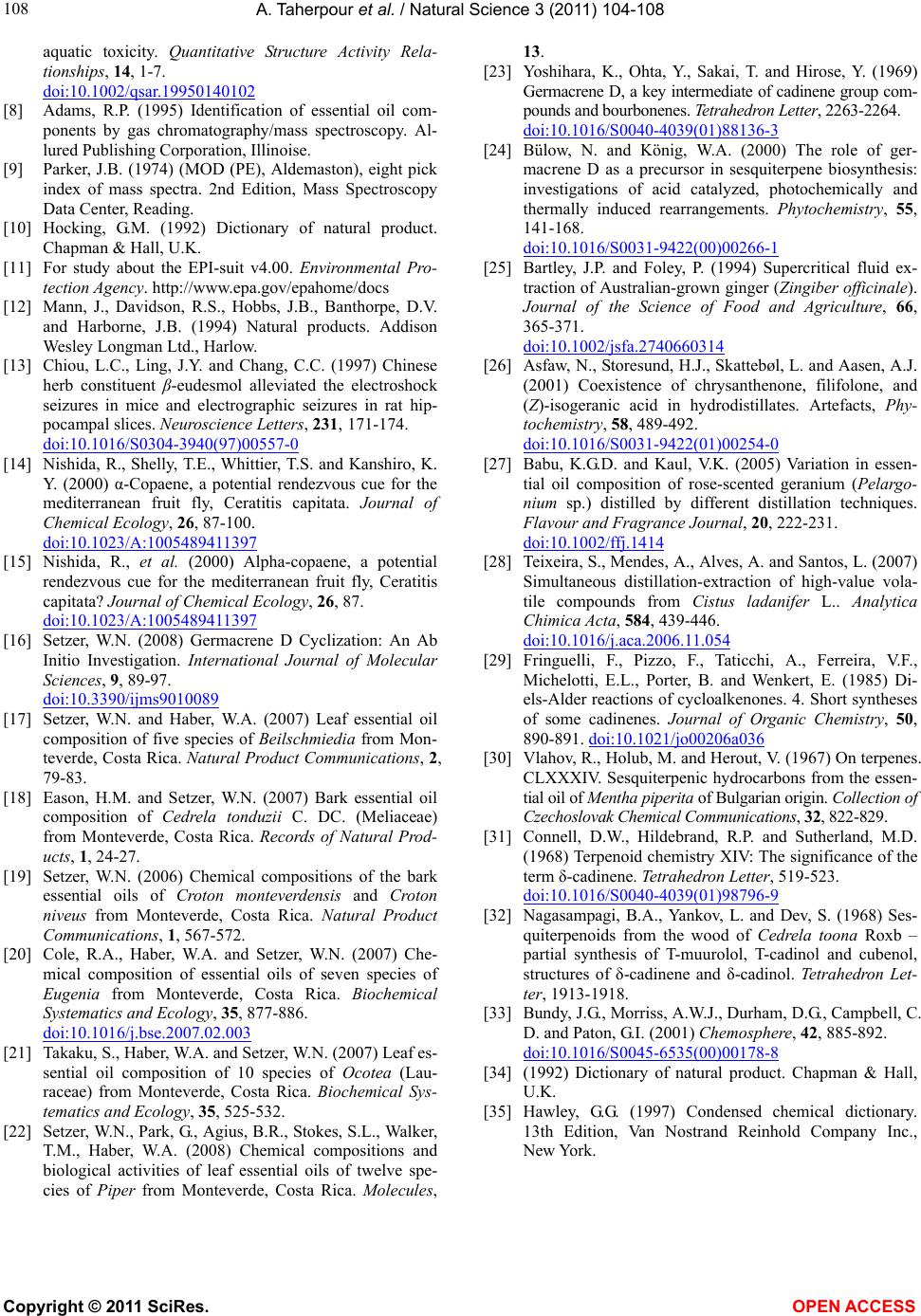
A. Taherpour et al. / Natural Science 3 (2011) 104-108
Copyright © 2011 SciRes. OPEN ACCESS
108
aquatic toxicity. Quantitative Structure Activity Rela-
tionships, 14, 1-7.
doi:10.1002/qsar.19950140102
[8] Adams, R.P. (1995) Identification of essential oil com-
ponents by gas chromatography/mass spectroscopy. Al-
lured Publishing Corporation, Illinoise.
[9] Parker, J.B. (1974) (MOD (PE), Aldemaston), eight pick
index of mass spectra. 2nd Edition, Mass Spectroscopy
Data Center, Reading.
[10] Hocking, G.M. (1992) Dictionary of natural product.
Chapman & Hall, U.K.
[11] For study about the EPI-suit v4.00. Environmental Pro-
tection Agency. http://www.epa.gov/epahome/docs
[12] Mann, J., Davidson, R.S., Hobbs, J.B., Banthorpe, D.V.
and Harborne, J.B. (1994) Natural products. Addison
Wesley Longman Ltd., Harlow.
[13] Chiou, L.C., Ling, J.Y. and Chang, C.C. (1997) Chinese
herb constituent β-eudesmol alleviated the electroshock
seizures in mice and electrographic seizures in rat hip-
pocampal slices. Neuroscience Letters, 231, 171-174.
doi:10.1016/S0304-3940(97)00557-0
[14] Nishida, R., Shelly, T.E., Whittier, T.S. and Kanshiro, K.
Y. (2000) α-Copaene, a potential rendezvous cue for the
mediterranean fruit fly, Ceratitis capitata. Journal of
Chemical Ecology, 26, 87-100.
doi:10.1023/A:1005489411397
[15] Nishida, R., et al. (2000) Alpha-copaene, a potential
rendezvous cue for the mediterranean fruit fly, Ceratitis
capitata? Journal of Chemical Ecology, 26, 87.
doi:10.1023/A:1005489411397
[16] Setzer, W.N. (2008) Germacrene D Cyclization: An Ab
Initio Investigation. International Journal of Molecular
Sciences, 9, 89-97.
doi:10.3390/ijms9010089
[17] Setzer, W.N. and Haber, W.A. (2007) Leaf essential oil
composition of five species of Beilschmiedia from Mon-
teverde, Costa Rica. Natural Product Communications, 2,
79-83.
[18] Eason, H.M. and Setzer, W.N. (2007) Bark essential oil
composition of Cedrela tonduzii C. DC. (Meliaceae)
from Monteverde, Costa Rica. Records of Natural Prod-
ucts, 1, 24-27.
[19] Setzer, W.N. (2006) Chemical compositions of the bark
essential oils of Croton monteverdensis and Croton
niveus from Monteverde, Costa Rica. Natural Product
Communications, 1, 567-572.
[20] Cole, R.A., Haber, W.A. and Setzer, W.N. (2007) Che-
mical composition of essential oils of seven species of
Eugenia from Monteverde, Costa Rica. Biochemical
Systematics and Ecology, 35, 877-886.
doi:10.1016/j.bse.2007.02.003
[21] Takaku, S., Haber, W.A. and Setzer, W.N. (2007) Leaf es-
sential oil composition of 10 species of Ocotea (Lau-
raceae) from Monteverde, Costa Rica. Biochemical Sys-
tematics and Ecology, 35, 525-532.
[22] Setzer, W.N., Park, G., Agius, B.R., Stokes, S.L., Walker,
T.M., Haber, W.A. (2008) Chemical compositions and
biological activities of leaf essential oils of twelve spe-
cies of Piper from Monteverde, Costa Rica. Molecules,
13.
[23] Yoshihara, K., Ohta, Y., Sakai, T. and Hirose, Y. (1969)
Germacrene D, a key intermediate of cadinene group com-
pounds and bourbonenes. Tetrahedron Letter, 2263-2264.
doi:10.1016/S0040-4039(01)88136-3
[24] Bülow, N. and König, W.A. (2000) The role of ger-
macrene D as a precursor in sesquiterpene biosynthesis:
investigations of acid catalyzed, photochemically and
thermally induced rearrangements. Phytochemistry, 55,
141-168.
doi:10.1016/S0031-9422(00)00266-1
[25] Bartley, J.P. and Foley, P. (1994) Supercritical fluid ex-
traction of Australian-grown ginger (Zingiber officinale).
Journal of the Science of Food and Agriculture, 66,
365-371.
doi:10.1002/jsfa.2740660314
[26] Asfaw, N., Storesund, H.J., Skattebøl, L. and Aasen, A.J.
(2001) Coexistence of chrysanthenone, filifolone, and
(Z)-isogeranic acid in hydrodistillates. Artefacts, Phy-
tochemistry, 58, 489-492.
doi:10.1016/S0031-9422(01)00254-0
[27] Babu, K.G.D. and Kaul, V.K. (2005) Variation in essen-
tial oil composition of rose-scented geranium (Pelargo-
nium sp.) distilled by different distillation techniques.
Flavour and Fragrance Journal, 20, 222-231.
doi:10.1002/ffj.1414
[28] Teixeira, S., Mendes, A., Alves, A. and Santos, L. (2007)
Simultaneous distillation-extraction of high-value vola-
tile compounds from Cistus ladanifer L.. Analytica
Chimica Acta, 584, 439-446.
doi:10.1016/j.aca.2006.11.054
[29] Fringuelli, F., Pizzo, F., Taticchi, A., Ferreira, V.F.,
Michelotti, E.L., Porter, B. and Wenkert, E. (1985) Di-
els-Alder reactions of cycloalkenones. 4. Short syntheses
of some cadinenes. Journal of Organic Chemistry, 50,
890-891. doi:10.1021/jo00206a036
[30] Vlahov, R., Holub, M. and Herout, V. (1967) On terpenes.
CLXXXIV. Sesquiterpenic hydrocarbons from the essen-
tial oil of Mentha piperita of Bulgarian origin. Collection of
Czechoslovak Chemical Communications, 32, 822-829.
[31] Connell, D.W., Hildebrand, R.P. and Sutherland, M.D.
(1968) Terpenoid chemistry XIV: The significance of the
term δ-cadinene. Tetrahedron Letter, 519-523.
doi:10.1016/S0040-4039(01)98796-9
[32] Nagasampagi, B.A., Yankov, L. and Dev, S. (1968) Ses-
quiterpenoids from the wood of Cedrela toona Roxb –
partial synthesis of T-muurolol, T-cadinol and cubenol,
structures of δ-cadinene and δ-cadinol. Tetrahedron Let-
ter, 1913-1918.
[33] Bundy, J.G., Morriss, A.W.J., Durham, D.G., Campbell, C.
D. and Paton, G.I. (2001) Chemosphere, 42, 885-892.
doi:10.1016/S0045-6535(00)00178-8
[34] (1992) Dictionary of natural product. Chapman & Hall,
U.K.
[35] Hawley, G.G. (1997) Condensed chemical dictionary.
13th Edition, Van Nostrand Reinhold Company Inc.,
New York.